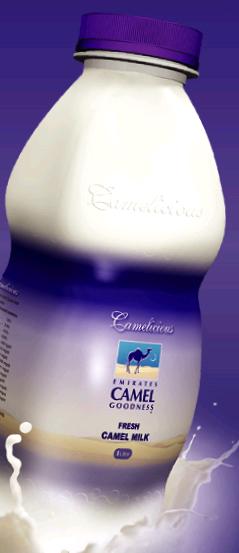Get camel milk now in China, India, Kenya, UAE... and, maybe by 2011 in Europe.
UAE expects to be the first supplier if the European Commission (EC) agrees to import camel's milk beginning possibly in 2011.
Frédéric Vincent, European Commission Spokesperson for Health and Consumer Policy told Relaxnews with regards to vetting camel milk for the European market "things are ongoing but far to be ready for a decision to allow UAE to export camel milk to the EU."
According to the Food and Agriculture Organization of the United Nations (FAO), camel milk is enjoyed fresh and soured throughout Asia, Middle East and Africa.
It is high in non-saturated fatty acids, insulin and vitamin C. The milk can have high water content (80-90%), its total protein is similar to cow milk and the amount of lactation can change the quality of taste from sweet to bitter.
The blogger of SusieofArabia described the taste, as "a lot like cow's milk except it is much richer - to me I can taste like a film of fat in my mouth after I swallow. A gallon of the stuff, freshly squeezed, costs 20 riyals, which is $5 US [€3.98]."
A paper presented at the 5th Dubai International Food Safety Conference in February claimed camel's milk does the body better than cow milk with its lower fat and cholesterol content plus it is rich in potassium, iron, sodium, and magnesium.
However if unpasturized it can cause brucellosis, also known as Bang's disease and rock fever. It is highly contagious and causes excessive sweating and muscle/joint aches.
The ezine Food Quad by the Indian publisher Ayushveda noted camel milk was a growing trend in December at Saras (milk parlors) and various camel milk brands were popping up on market shelves making it easier to find for healthy cures.
Many use the milk to improve skin tone, cure impotence, reduce wrinkles and help diabetes. Ethiopians use camel milk as an aphrodisac while Indians believe it enhances their sexual abilities.
Mauritania is known for its flavored camel milk and 'camelbert', camel-milk cheese, under the brand Caravane and in Kenya the company Vital Camel Milk makes Cold Hump, organic camel milk ice in a variety of flavors including macadamia nut & caramel, pineapple & coconut and cinnamon & cardamom.
Camel milk is currently used in a variety of products antibacterial soap, yogurt, cheese, ice cream even camel-milk chocolate (made in Vienna with powdered camel-milk from Dubai and exported to the Middle East), perhaps Europeans will experience all these products and develop new ones in 2011.

Join our commenting forum
Join thought-provoking conversations, follow other Independent readers and see their replies
Comments